Abstract
A study was undertaken in New York State to determine the changes in dental fluorosis prevalence from 1955 to 1986 in fluoridated Newburgh and non-fluoridated Kingston children. The frequency and severity of dental fluorosis among 884 7-14-year-old children were measured by two dentists utilizing Dean's Index. Data regarding residential and fluoride history were obtained from the parents of participants. Among the Newburgh residents, the prevalence of dental fluorosis (very mild to moderate) varied from a low of 5 per cent for the 9-10-year-old group to a high of 9.4 per cent for 11-12-year-olds. Except for the 13-14-year-old group, children in non-fluoridated Kingston had the lowest dental fluorosis prevalence rates. A comparison of Dean's Community Fluorosis Indices to the 1955 baseline data obtained from studies conducted after 10 years of fluoridation in Newburgh revealed no changes of consequence among Newburgh residents. However, the changes are apparent for Kingston residents, indicating the availability of fluorides in non-fluoridated areas. The increased risk for dental fluorosis for Kingston residents appears to be from the use of fluoride tablets. An analysis of dental caries data revealed that caries prevalence declined substantially in both fluoridated and non-fluoridated areas.
Full text
PDF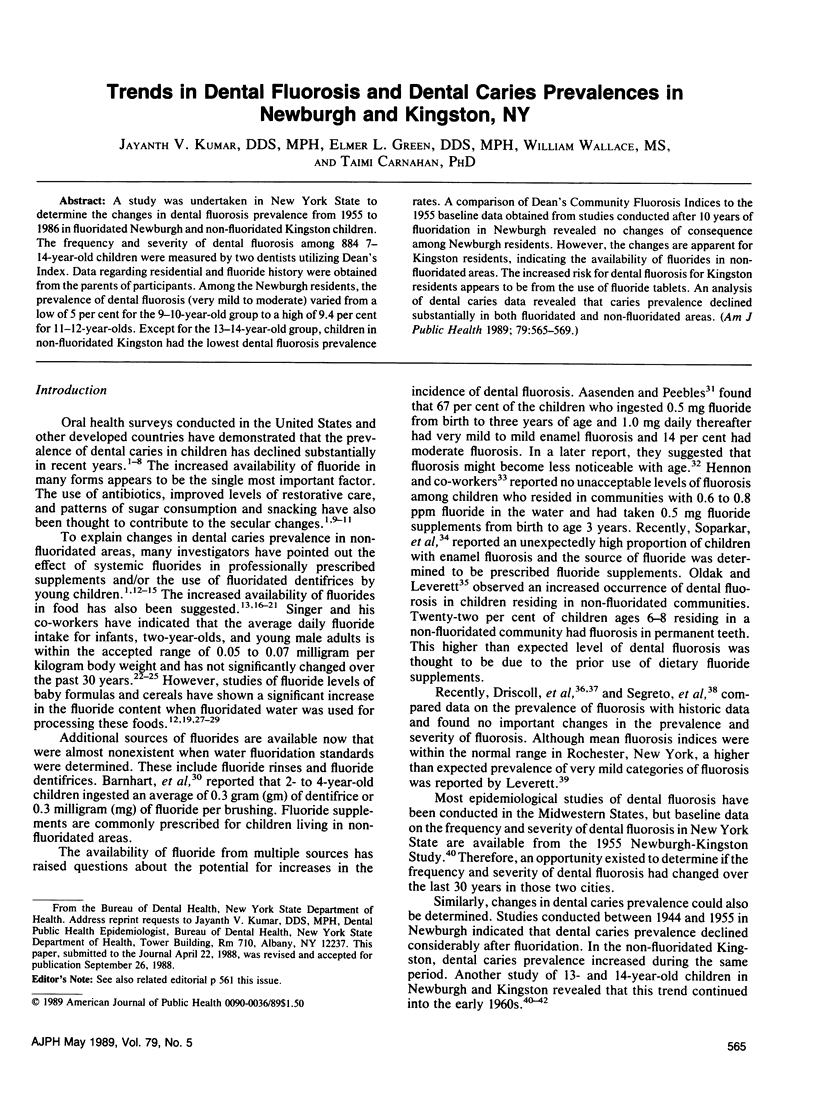
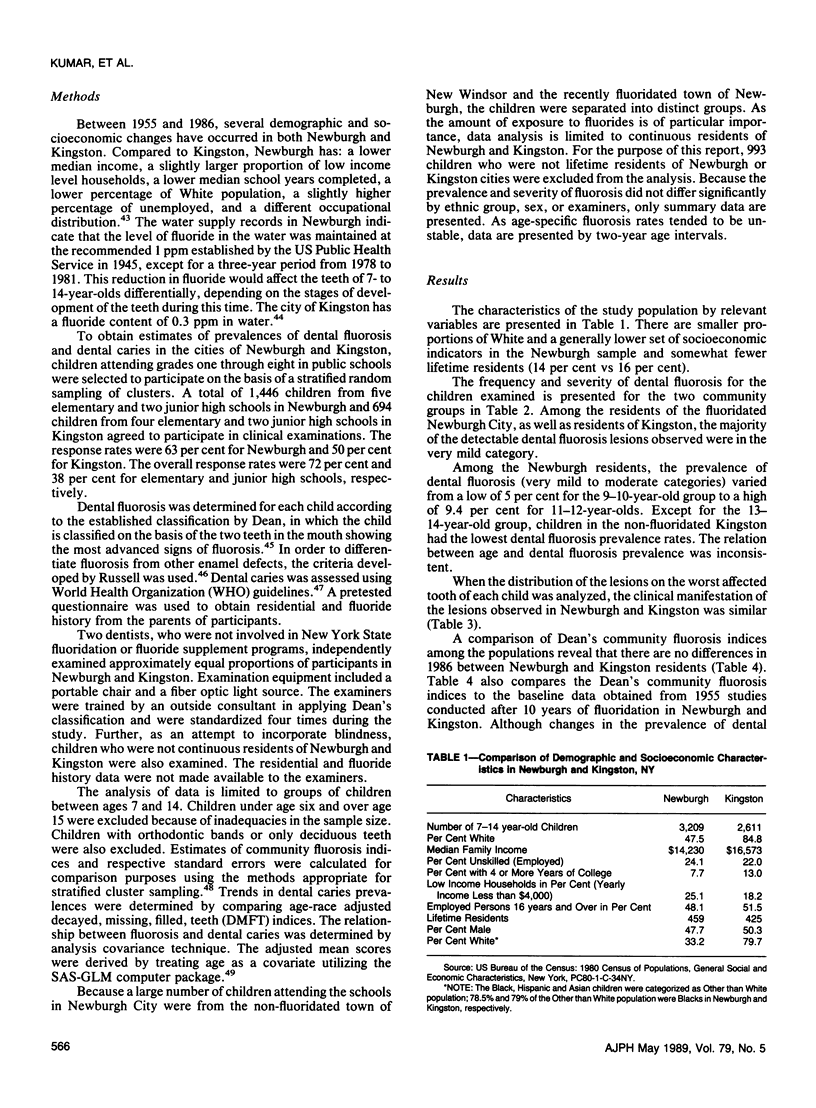
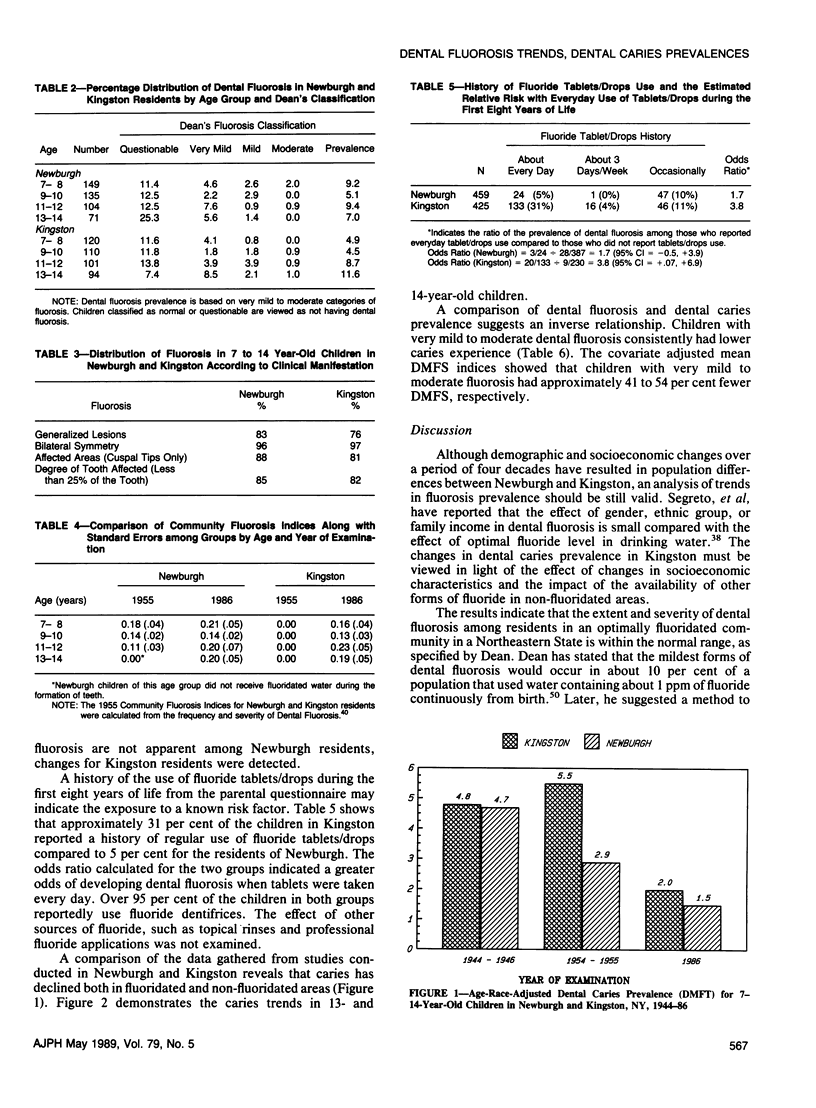
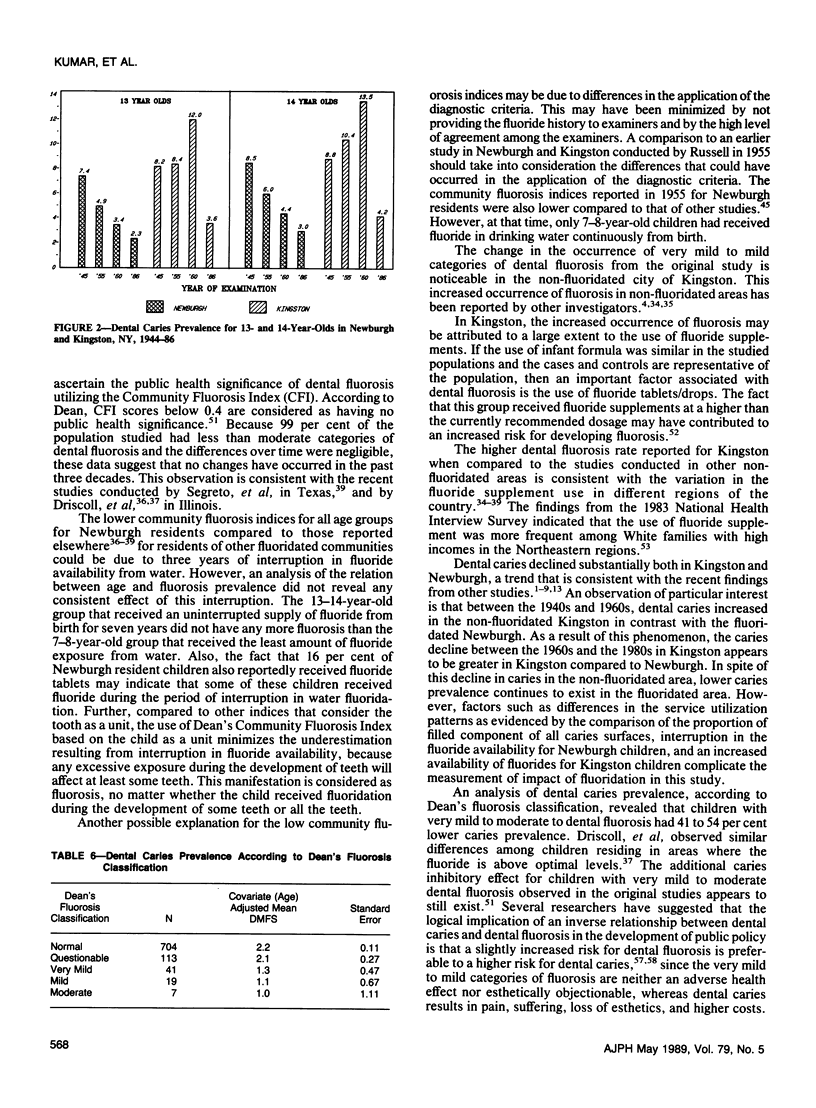
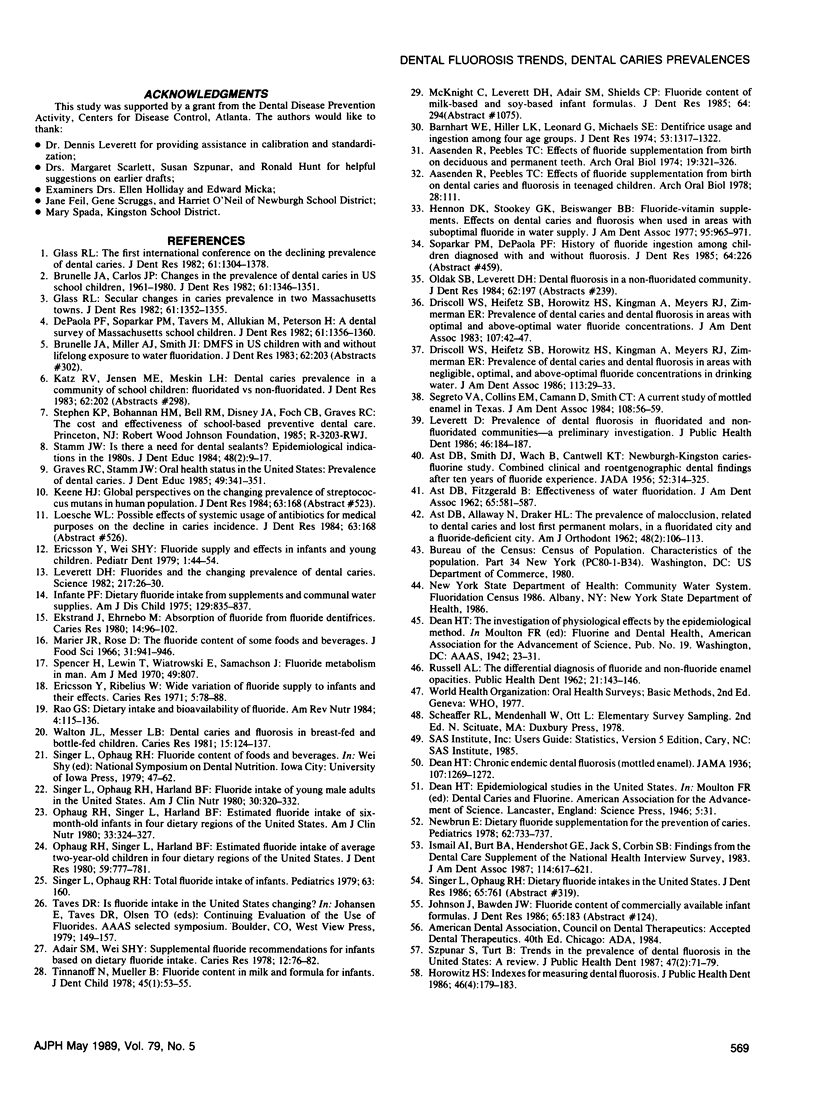
Selected References
These references are in PubMed. This may not be the complete list of references from this article.
- AST D. B., FITZGERALD B. Effectiveness of water fluoridation. J Am Dent Assoc. 1962 Nov;65:581–587. doi: 10.14219/jada.archive.1962.0311. [DOI] [PubMed] [Google Scholar]
- AST D. B., SMITH D. J., WACHS B., CANTWELL K. T. Newburgh-Kingston caries-fluorine study. XIV. Combined clinical and roentgenographic dental findings after ten years of fluoride experience. J Am Dent Assoc. 1956 Mar;52(3):314–325. doi: 10.14219/jada.archive.1956.0042. [DOI] [PubMed] [Google Scholar]
- Aasenden R., Peebles T. C. Effects of fluoride supplementation from birth on human deciduous and permanent teeth. Arch Oral Biol. 1974 Apr;19(4):321–326. doi: 10.1016/0003-9969(74)90194-0. [DOI] [PubMed] [Google Scholar]
- Aasenden R., Peebles T. C. Effects of fluroide supplementation from birth on dental caries and fluorosis in teenaged children. Arch Oral Biol. 1978;23(2):111–115. doi: 10.1016/0003-9969(78)90147-4. [DOI] [PubMed] [Google Scholar]
- Adair S. M., Wei S. H. Supplemental fluoride recommendations for infant based on dietary fluoride intake. Caries Res. 1978;12(2):76–82. doi: 10.1159/000260318. [DOI] [PubMed] [Google Scholar]
- Barnhart W. E., Hiller L. K., Leonard G. J., Michaels S. E. Dentifrice usage and ingestion among four age groups. J Dent Res. 1974 Nov-Dec;53(6):1317–1322. doi: 10.1177/00220345740530060301. [DOI] [PubMed] [Google Scholar]
- Driscoll W. S., Horowitz H. S., Meyers R. J., Heifetz S. B., Kingman A., Zimmerman E. R. Prevalence of dental caries and dental fluorosis in areas with negligible, optimal, and above-optimal fluoride concentrations in drinking water. J Am Dent Assoc. 1986 Jul;113(1):29–33. doi: 10.14219/jada.archive.1986.0141. [DOI] [PubMed] [Google Scholar]
- Driscoll W. S., Horowitz H. S., Meyers R. J., Heifetz S. B., Kingman A., Zimmerman E. R. Prevalence of dental caries and dental fluorosis in areas with optimal and above-optimal water fluoride concentrations. J Am Dent Assoc. 1983 Jul;107(1):42–47. doi: 10.14219/jada.archive.1983.0196. [DOI] [PubMed] [Google Scholar]
- Ekstrand J., Ehrnebo M. Absorption of fluoride from fluoride dentifrices. Caries Res. 1980;14(2):96–102. doi: 10.1159/000260442. [DOI] [PubMed] [Google Scholar]
- Ericsson Y., Ribelius U. Wide variations of fluoride supply to infants and their effect. Caries Res. 1971;5(1):78–88. doi: 10.1159/000259734. [DOI] [PubMed] [Google Scholar]
- Ericsson Y., Wei S. H. Fluoride supply and effects in infants and young children. Pediatr Dent. 1979 Mar;1(1):44–54. [PubMed] [Google Scholar]
- Graves R. C., Stamm J. W. Oral health status in the United States: prevalence of dental caries. J Dent Educ. 1985 Jun;49(6):341–353. [PubMed] [Google Scholar]
- Hennon D. K., Stookey G. K., Beiswanger B. B. Fluoride-vitamin supplements: effects on dental caries and fluorosis when used in areas with suboptimum fluoride in the water supply. J Am Dent Assoc. 1977 Nov;95(5):965–971. doi: 10.14219/jada.archive.1977.0166. [DOI] [PubMed] [Google Scholar]
- Horowitz H. S. Indexes for measuring dental fluorosis. J Public Health Dent. 1986 Fall;46(4):179–183. doi: 10.1111/j.1752-7325.1986.tb03139.x. [DOI] [PubMed] [Google Scholar]
- Infante P. F. Dietary fluoride intake from supplements and communal water supplies. Am J Dis Child. 1975 Jul;129(7):835–837. doi: 10.1001/archpedi.1975.02120440059012. [DOI] [PubMed] [Google Scholar]
- Ismail A. I., Burt B. A., Hendershot G. E., Jack S., Corbin S. B. Findings from the Dental Care Supplement of the National Health Interview Survey, 1983. J Am Dent Assoc. 1987 May;114(5):617–621. doi: 10.14219/jada.archive.1987.0150. [DOI] [PubMed] [Google Scholar]
- Leverett D. H. Fluorides and the changing prevalence of dental caries. Science. 1982 Jul 2;217(4554):26–30. doi: 10.1126/science.7089534. [DOI] [PubMed] [Google Scholar]
- Leverett D. Prevalence of dental fluorosis in fluoridated and nonfluoridated communities--a preliminary investigation. J Public Health Dent. 1986 Fall;46(4):184–187. doi: 10.1111/j.1752-7325.1986.tb03140.x. [DOI] [PubMed] [Google Scholar]
- Newbrun E. Dietary fluoride supplementation for the prevention of caries. Pediatrics. 1978 Nov;62(5):733–737. [PubMed] [Google Scholar]
- Ophaug R. H., Singer L., Harland B. F. Estimated fluoride intake of 6-month-old infants in four dietary regions of the United States. Am J Clin Nutr. 1980 Feb;33(2):324–327. doi: 10.1093/ajcn/33.2.324. [DOI] [PubMed] [Google Scholar]
- Ophaug R. H., Singer L., Harland B. F. Estimated fluoride intake of average two-year-old children in four dietary regions of the United States. J Dent Res. 1980 May;59(5):777–781. doi: 10.1177/00220345800590050501. [DOI] [PubMed] [Google Scholar]
- Rao G. S. Dietary intake and bioavailability of fluoride. Annu Rev Nutr. 1984;4:115–136. doi: 10.1146/annurev.nu.04.070184.000555. [DOI] [PubMed] [Google Scholar]
- Segreto V. A., Collins E. M., Camann D., Smith C. T. A current study of mottled enamel in Texas. J Am Dent Assoc. 1984 Jan;108(1):56–59. doi: 10.14219/jada.archive.1984.0197. [DOI] [PubMed] [Google Scholar]
- Singer L., Ophaug R. H., Harland B. F. Fluoride intakes of young male adults in the United States. Am J Clin Nutr. 1980 Feb;33(2):328–332. doi: 10.1093/ajcn/33.2.328. [DOI] [PubMed] [Google Scholar]
- Spencer H., Lewin I., Wistrowski E., Samachson J. Fluoride metabolism in man. Am J Med. 1970 Dec;49(6):807–813. doi: 10.1016/s0002-9343(70)80062-6. [DOI] [PubMed] [Google Scholar]
- Stamm J. W. Is there a need for dental sealants? Epidemiological indications in the 1980s. J Dent Educ. 1984 Feb;48(2 Suppl):9–17. [PubMed] [Google Scholar]
- Szpunar S. M., Burt B. A. Trends in the prevalence of dental fluorosis in the United States: a review. J Public Health Dent. 1987 Spring;47(2):71–79. doi: 10.1111/j.1752-7325.1987.tb01980.x. [DOI] [PubMed] [Google Scholar]
- Tinanoff N., Mueller B. Fluoride content in milk and formula for infants. ASDC J Dent Child. 1978 Jan-Feb;45(1):53–55. [PubMed] [Google Scholar]
- Walton J. L., Messer L. B. Dental caries and fluorosis in breast-fed and bottle-fed children. Caries Res. 1981;15(2):124–137. doi: 10.1159/000260511. [DOI] [PubMed] [Google Scholar]


